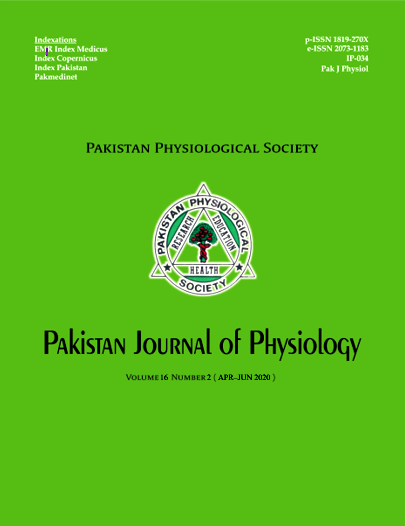Deciphering Adiponectin-Insulin Resistance nexus in normal pregnant versus non-pregnant women
DOI:
https://doi.org/10.69656/pjp.v16i2.1209Keywords:
adiponectin, gestational diabetes, Type 2 diabetes mellitus, homeostatic model assessment of insulin resistanceAbstract
Background: Insulin resistance in pregnancy leading to gestational diabetes is big cause of mortality and morbidity in Pakistan. Research shows that serum adiponectin has some role to play in establishment of insulin resistance seen in gestation. Present study was aimed to see if serum adiponectin is a predictive factor for insulin resistance in early pregnancy.
Methods: This case control study was conducted at Army Medical College and Centre for Research in Experimental and Analytical Medicine (CREAM) in alliance with Military Hospital; Rawalpindi.60 subjects were recruited for this study. 30 were categorized as group I and were normal healthy females. 30 age matched pregnant females with normal glucose tolerance were placed in group II. ELISA technique was used to measure serum insulin and serum adiponectin levels. Fasting glucose levels were measured via glucometer. HOMA – IR was used to assess the insulin resistance (IR). Mean values of serum adiponectin, glucose, insulin and HOMA-IR were calculated. Correlation analysis was done between serum adiponectin and IR by applying Pearson correlation test.
Results: Serum adiponectin levels in both groups showed no comparable difference. Non significant negative correlation was observed between serum adiponectin and HOMA – IR in group II pregnant females.
Conclusion: Non significant negative correlation between serum adiponectin and HOMA – IR reveals that there might be some other factor other than serum adiponectin leading to insulin resistance. It also focuses towards increasing the sample size in further studies to see any significant negative correlation between studied parameters.
Downloads
Downloads
Published
How to Cite
Issue
Section
License
The author(s) retain the copyrights and allow their publication in Pakistan Journal of Physiology, Pak J Physiol, PJP to be FREE for research and academic purposes. It can be downloaded and stored, printed, presented, projected, cited and quoted with full reference of, and acknowledgement to the author(s) and the PJP. The contents are published with an international CC-BY-ND-4.0 License.











